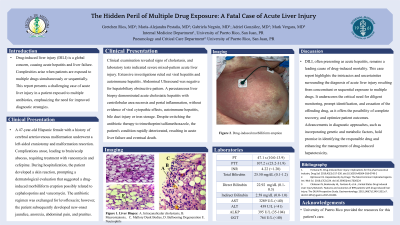Monday Poster Session
Category: Liver
P2543 - The Hidden Peril of Multiple Drug Exposure: A Fatal Case of Acute Liver Injury
Monday, October 23, 2023
10:30 AM - 4:15 PM PT
Location: Exhibit Hall

Has Audio

Gretchen Rios, MD
University of Puerto Rico
San Juan, Dominican Republic
Presenting Author(s)
Gretchen Rios, MD, Gabriela Negron, MD, Maria-Alejandra Pestana, MD, Adriel Gonzalez, MD, Mark Vergara, MD
University of Puerto Rico, San Juan, Puerto Rico
Introduction: Drug-induced liver injury (DILI) is a global concern, causing acute hepatitis and liver failure. Complexities arise when patients are exposed to multiple drugs simultaneously or sequentially. This report presents a challenging case of acute liver injury in a patient exposed to multiple antibiotics, emphasizing the need for improved diagnostic strategies.
Case Description/Methods: A 47-year-old Hispanic female with a history of cerebral arteriovenous malformation underwent a left-sided craniotomy and malformation resection. Complications arose, leading to brain/scalp abscess, requiring treatment with vancomycin and cefepime. During hospitalization, the patient developed a skin reaction, prompting a dermatological evaluation that suggested a drug-induced morbilliform eruption possibly related to cephalosporins and vancomycin. The antibiotic regimen was exchanged for levofloxacin; however, the patient subsequently developed new-onset jaundice, anorexia, abdominal pain, and pruritus. Clinical examination revealed signs of cholestasis, and laboratory tests indicated severe mixed-pattern acute liver injury. Extensive investigations ruled out viral hepatitis and autoimmune hepatitis. Abdominal Ultrasound was negative for a hepatobiliary obstructive pattern. A percutaneous liver biopsy demonstrated acute cholestatic hepatitis with centrilobular area necrosis and portal inflammation, without evidence of viral cytopathic effects, autoimmune hepatitis, bile duct injury, or iron storage. Despite switching the antibiotic therapy to trimethoprim/sulfamethoxazole, the patient's condition rapidly deteriorated, resulting in acute liver failure and eventual death.
Discussion: DILI, often presenting as acute hepatitis, remains a leading cause of drug-induced mortality. This case report highlights the intricacies and uncertainties surrounding the diagnosis of acute liver injury resulting from concomitant or sequential exposure to multiple drugs. It underscores the critical need for diligent monitoring, prompt identification, and cessation of the offending drug, as it offers the possibility of complete recovery, and improves patient outcomes. Advancements in diagnostic approaches, such as incorporating genetic and metabolic factors, hold promise in identifying the responsible drug and enhancing the management of drug-induced hepatotoxicity.
Disclosures:
Gretchen Rios, MD, Gabriela Negron, MD, Maria-Alejandra Pestana, MD, Adriel Gonzalez, MD, Mark Vergara, MD. P2543 - The Hidden Peril of Multiple Drug Exposure: A Fatal Case of Acute Liver Injury, ACG 2023 Annual Scientific Meeting Abstracts. Vancouver, BC, Canada: American College of Gastroenterology.
University of Puerto Rico, San Juan, Puerto Rico
Introduction: Drug-induced liver injury (DILI) is a global concern, causing acute hepatitis and liver failure. Complexities arise when patients are exposed to multiple drugs simultaneously or sequentially. This report presents a challenging case of acute liver injury in a patient exposed to multiple antibiotics, emphasizing the need for improved diagnostic strategies.
Case Description/Methods: A 47-year-old Hispanic female with a history of cerebral arteriovenous malformation underwent a left-sided craniotomy and malformation resection. Complications arose, leading to brain/scalp abscess, requiring treatment with vancomycin and cefepime. During hospitalization, the patient developed a skin reaction, prompting a dermatological evaluation that suggested a drug-induced morbilliform eruption possibly related to cephalosporins and vancomycin. The antibiotic regimen was exchanged for levofloxacin; however, the patient subsequently developed new-onset jaundice, anorexia, abdominal pain, and pruritus. Clinical examination revealed signs of cholestasis, and laboratory tests indicated severe mixed-pattern acute liver injury. Extensive investigations ruled out viral hepatitis and autoimmune hepatitis. Abdominal Ultrasound was negative for a hepatobiliary obstructive pattern. A percutaneous liver biopsy demonstrated acute cholestatic hepatitis with centrilobular area necrosis and portal inflammation, without evidence of viral cytopathic effects, autoimmune hepatitis, bile duct injury, or iron storage. Despite switching the antibiotic therapy to trimethoprim/sulfamethoxazole, the patient's condition rapidly deteriorated, resulting in acute liver failure and eventual death.
Discussion: DILI, often presenting as acute hepatitis, remains a leading cause of drug-induced mortality. This case report highlights the intricacies and uncertainties surrounding the diagnosis of acute liver injury resulting from concomitant or sequential exposure to multiple drugs. It underscores the critical need for diligent monitoring, prompt identification, and cessation of the offending drug, as it offers the possibility of complete recovery, and improves patient outcomes. Advancements in diagnostic approaches, such as incorporating genetic and metabolic factors, hold promise in identifying the responsible drug and enhancing the management of drug-induced hepatotoxicity.
Disclosures:
Gretchen Rios indicated no relevant financial relationships.
Gabriela Negron indicated no relevant financial relationships.
Maria-Alejandra Pestana indicated no relevant financial relationships.
Adriel Gonzalez indicated no relevant financial relationships.
Mark Vergara indicated no relevant financial relationships.
Gretchen Rios, MD, Gabriela Negron, MD, Maria-Alejandra Pestana, MD, Adriel Gonzalez, MD, Mark Vergara, MD. P2543 - The Hidden Peril of Multiple Drug Exposure: A Fatal Case of Acute Liver Injury, ACG 2023 Annual Scientific Meeting Abstracts. Vancouver, BC, Canada: American College of Gastroenterology.
